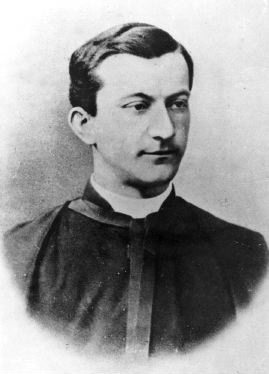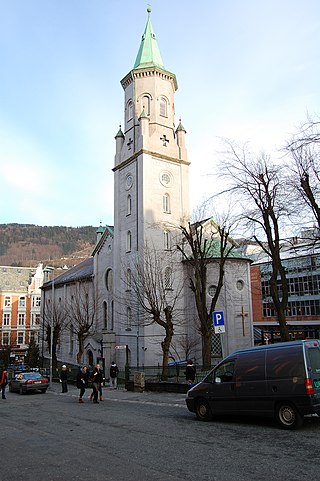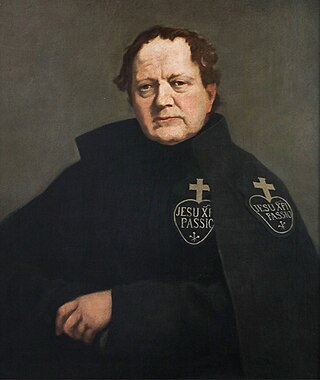
Sigrid Undset was a Danish-born Norwegian novelist. She was awarded the Nobel Prize for Literature in 1928.

Father Damien or Saint Damien of Molokai, SS.CC. or Saint Damien De Veuster, born Jozef De Veuster, was a Roman Catholic priest from Belgium and member of the Congregation of the Sacred Hearts of Jesus and Mary, a missionary religious institute. He was recognized for his ministry, which he led from 1873 until his death in 1889, in the Kingdom of Hawaiʻi to people with leprosy, who lived in government-mandated medical quarantine in a settlement on the Kalaupapa Peninsula of Molokaʻi.

John of Ávila was a Spanish priest, preacher, scholastic author, and religious mystic, who has been declared a saint and Doctor of the Church by the Catholic Church. He is called the "Apostle of Andalusia", for his extensive ministry in that region.

The Barnabites, officially named as the Clerics Regular of Saint Paul, are a religious order of clerics regular founded in 1530 in the Catholic Church. They are associated with the Angelic Sisters of St. Paul and the members of the Barnabite lay movement.

Anthony Maria Zaccaria, CRSP was an early leader of the Counter Reformation, the founder of religious orders (Barnabites) and a promoter of the devotion to the Passion of Christ, the Eucharist and the renewal of the religious life among the laity. He is venerated as a saint in the Catholic Church, which celebrates his feast day on 5 July.

Léon-Gustave Dehon, SCJ, also known as Jean of the Sacred Heart, was a French Catholic priest and the founder of the Congregation of the Sacred Heart of Jesus.
Canons regular are priests who live in community under a rule and are generally organised into religious orders, differing from both secular canons and other forms of religious life, such as clerics regular, designated by a partly similar terminology.
The Catholic Church in the Nordic countries was the only Christian church in that region before the Reformation in the 16th century. Since then, Scandinavia has been a mostly non-Catholic (Lutheran) region and the position of Nordic Catholics for many centuries after the Reformation was very difficult due to legislation outlawing Catholicism. However, the Catholic population of the Nordic countries has seen some growth in the region in recent years, particularly in Norway, in large part due to immigration and to a lesser extent conversions among the native population.

The Catholic Church in Norway is part of the worldwide Catholic Church. As of May 2014, there were over 151,000 registered Catholics in Norway. It is claimed there are many Catholics who are not registered with their personal identification number and who are not reported by the local church; the full number may be as high as 230,000, 70% of whom were born abroad. That constitutes about 5% of the population, making Norway the most Catholic country in Nordic Europe.
Clerics regular are clerics who are members of a religious order under a rule of life (regular). Clerics regular differ from canons regular in that they devote themselves more to pastoral care, in place of an obligation to the praying of the Liturgy of the Hours in common, and have fewer observances in their rule of life.

Ignatius of St Paul, born as George Spencer, was a son of the 2nd Earl Spencer. He converted from Anglicanism to the Roman Catholic Church and entered the Passionist religious order in 1847 and spent his life working for the conversion of England to the Catholic faith.

The Master of Hestviken is a tetralogy about medieval Norway written by Sigrid Undset. It was originally published in Norwegian as two volumes Olav Audunssøn i Hestviken and Olav Audunssøn og Hans Børn, from 1925 to 1927. Hestviken is a fictional mediaeval farm on the East side of the Oslo fjord. The series is set partly during the Civil war era in Norway, in which period the Bagler faction frequently established themselves in the nearby Viken area. It's inspired by the summer cottages located in Hvitsten, near Drobak. In the 1920s, Sigrid Undset resided there for a brief period.
Hallvard Rieber-Mohn was a Norwegian Dominican priest and author.

Francis Xavier Mary Bianchi, was an Italian Barnabite priest and noted scholar, who also gained a reputation for sanctity during his lifetime from both his commitment to his students and to the poor of Naples. He has been proclaimed a saint by the Catholic Church and declared the Apostle of the city.

Jacques Sevin SJ, was a French Jesuit known for his role in the introduction of Scouting to France.

The Priest Barracks of Dachau Concentration incarcerated clergy who had opposed the Nazi regime of Adolf Hitler. From December 1940, Berlin ordered the transfer of clerical prisoners held at other camps, and Dachau became the centre for imprisonment of clergymen. Of a total of 2,720 clerics recorded as imprisoned at Dachau some 2,579 were Roman Catholics. Among the other denominations, there were 109 Protestants, 22 Orthodox, 8 Old Catholics and Mariavites and 2 Muslims. Members of the Catholic Society of Jesus (Jesuits) were the largest group among the incarcerated clergy at Dachau.

Leonardo Murialdo was an Italian Roman Catholic priest and the co-founder of the Congregation of Saint Joseph - also known as the Murialdines. Murialdo's call to the priesthood did not manifest until late in his education in Savona; he pursued his ecclesial studies and was ordained as such in 1851 before dedicating himself to social work alongside the poor and with adolescent men. This put him into contact with other priests of the era such as Giovanni Bosco and Giuseppe Cafasso who held Murialdo in great esteem. His zeal for social concern saw his frequent calls for an end to worker exploitation and the granting of further rights to workers in factories.

Carlo Maria Bascapè - born Giovanni Francesco Bascapè - was an Italian Roman Catholic prelate who served as Bishop of Novara from 1593 until his death. He was a close friend of Saint Charles Borromeo and assumed the first half of his religious name in honor of him.

Giovanni Merlini was an Italian Roman Catholic priest and a professed member in the Missionaries of the Precious Blood. Merlini was a close friend of Saint Gaspare del Bufalo who founded the order and was also a close friend to Pope Pius IX who provided assistance in helping the order spread for its activities. He also served as the third Moderator General for the order from 1847 until his death. He was also a noted spiritual director and provided spiritual counsel to Saint Maria de Mattias as she went establishing a religious congregation of her own.















